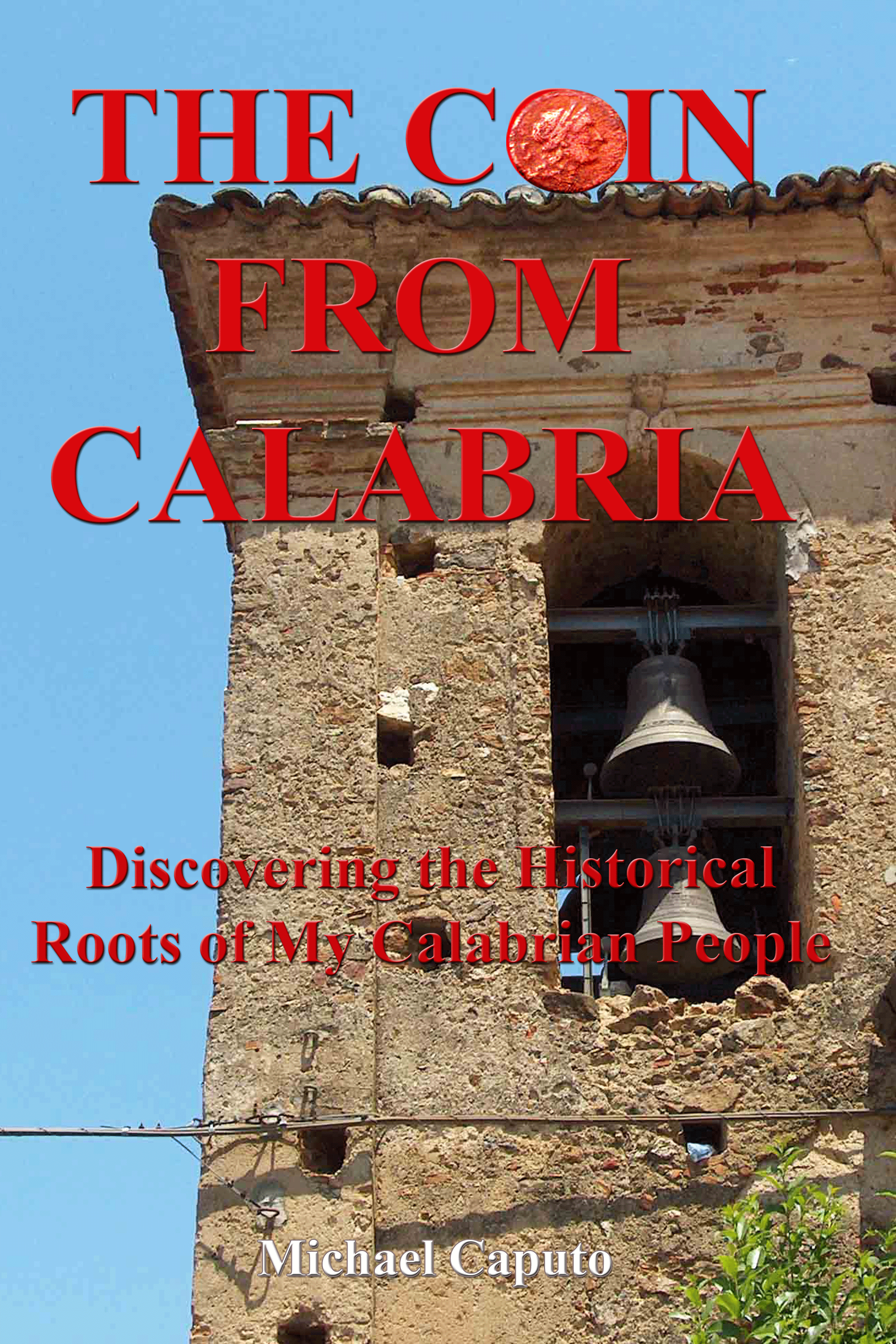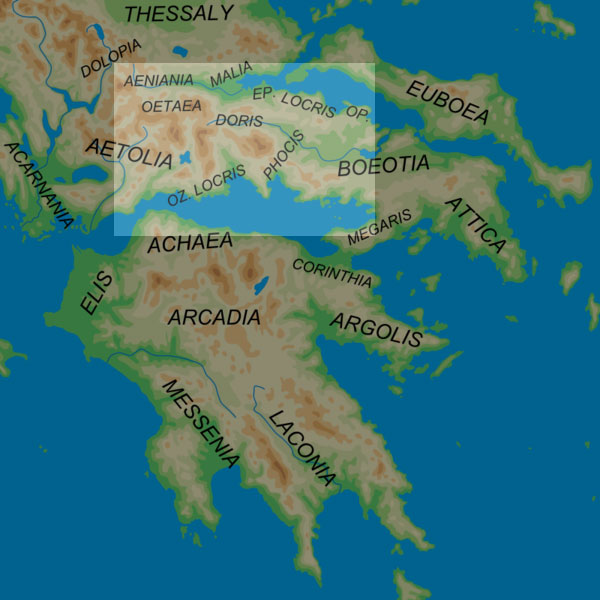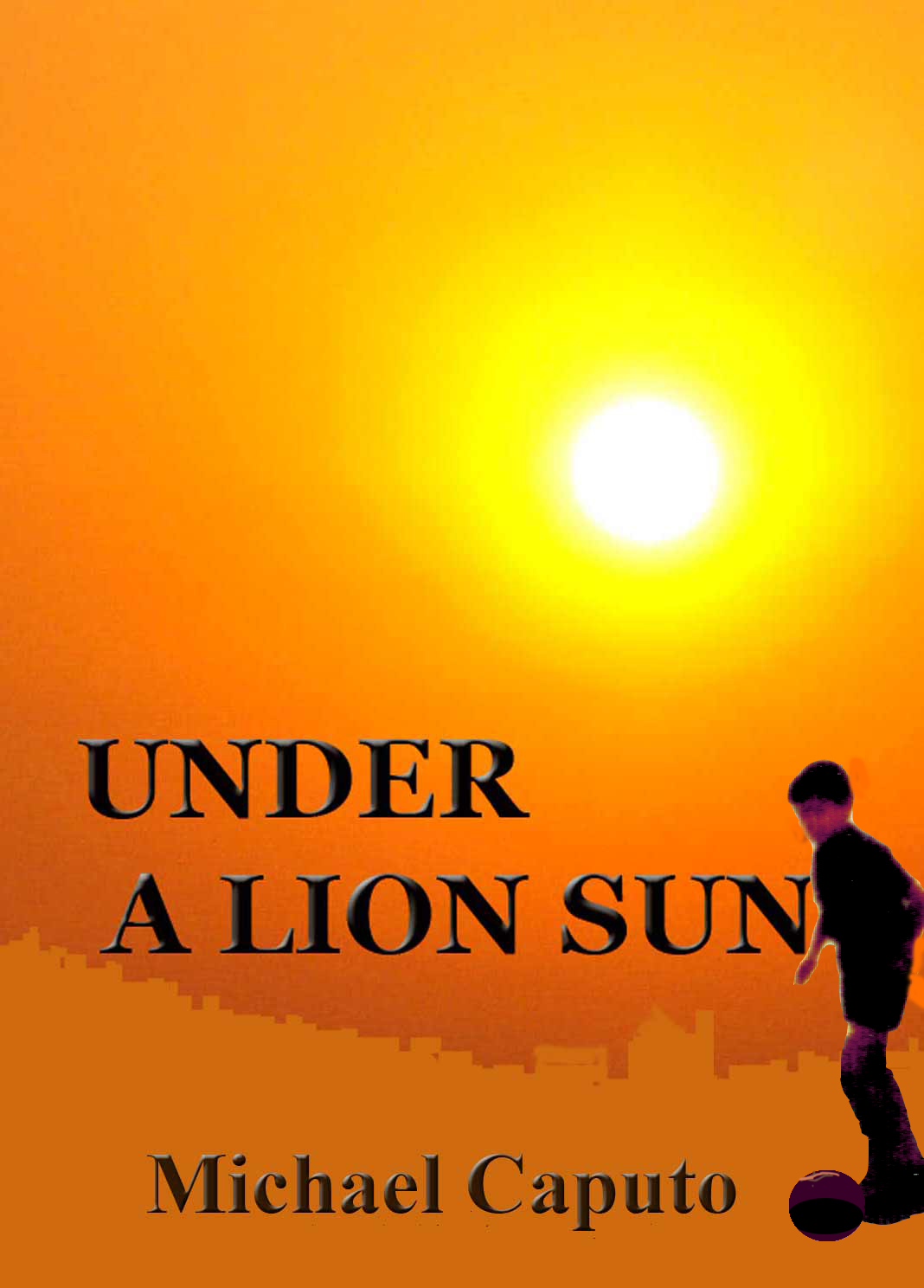| |
CAPISTRANO:
A GRIPPING HISTORY
Some time
ago, I decided to inform our Capistrano Descendents Group on Facebook of our
common and gripping historical past. I am now including that information on
this site as well for your enlightenment.
|
What follows is a very brief summary of our
Capistrano history. If you would like to read the more detailed
version,
CLICK HERE.
|
|
| |
| |
IMPORTANT ANNOUNCEMENT
| |
Detailed information on
Capistrano and Calabria's history mmay be found in,
THE COIN
FROM CALABRIA: DISCOVERING THE HISTORICAL ROOTS OF MY CALABRIAN
PEOPLE,
by award-winning author, Michael Caputo. The book
details many enthralling events in the history of Calabria,
a magical Region in Southern Italy, all the
way back to the sixth century B.C. THE COIN FROM CALABRIA is a very
enlightening book for people who find their roots in Calabria,
that want to know more about their ancestors' history.
It is also enlightening for anyone who is interested in exotic
lands and cultures.
|
|
| |
|
|
| |
Both the paperback
and e-book versions are available on Amazon in your country.
NEW BOOK ABOUT
CAPISTRANO AND CALABRIA:
UNDER A LION SUN:
Childhood Days of Joy and Sorrow in Old Calabria
Read info at the end
of this page.
|
|
| |
|
|
|
|
|
|
| |
|
|
| |

THE
COIN FROM CALABRIA
DISCOVERING THE HISTORICAL ROOTS OF MY CALABRIAN PEOPLE |
|
|
|
|
Dear "Capistrano Descendents" members,
I had promised that on occasion I would share
with you some info about our town's past and some updates on the present.
I would like to keep my promise today by
asking all of you the following questions: Did you know that our people
spoke Greek up to around 400 years ago and that we still have Greek words in
our dialect? Furthermore, did you know that some areas in the Capistrano
territory actually have Greek names? Lastly, did you know that Southern
Italy was, and still is, called by some, "Magna Grecia" (Great Greece)?
Are you perplexed? How could our ancestors be Italians and yet speak Greek?
This is the
answer: About three thousand years ago, plus or minus, several Greek tribes
moved into the coastal regions of central and southern Italy. As the Latins (The Romans) started conquering Italy, most
of the Greek immigration continued but only into the south of Italy and
Calabria and Sicily in particular. The Greek colonists occupied mostly the
coastal areas while the mountainous area was under the control of the "Brutii"
or "Bruzi," as their are known in Italian.
The Bruzi were a central Italian tribe that
moved down into Calabria. Therefore, for hundreds of years the Bruzi and the
Greeks lived side by side with few problems. At one point the Bruzi
conquered most of Calabria, but not for long.
When the Romans tried to conquer Calabria,
the stubborn Bruzi fought ferociously and succeeded in stopping the Romans
on several occasions. Finally the Romans were fed up, sent in a huge army
and "almost" wiped them all out. That is the point when the Bruzis
dwindled and slowly disappeared as an ethnic group.
The Bruzi blood, to a very small extent, is still
in us. Most of our blood, though, is Greek, with also a high amount of Latin blood.
We Southern Italians are in part the proud descendents of the great ancient
Greeks, the people who are the foundation of the Western world, thanks to
their great philosophers, artists and scientists.
Next time we will deal specifically with our
Capistranesi people and how they ended up where they are today.
Keel well.
Mike (Michele)
|
|

| |
| |
|
|
| |
Our Greek ancestors, came
mostly from the Greek state named Locris accompanied, according
to some, by people from
the state of Phocis.
|
|
| |
|
|
|
|
|
|
|
CAPISTRANO HISTORY (Part 2)
Dear Capistrano Descendents,
A few days ago, I shared with you a “general” history of the early peoples
that lived in Calabria. I mentioned the three groups that make up our genes:
the Greeks, the Romans and the Brutii (Bruzi).
What I forgot to mention is that there are about 30 communities in the
Cosenza province (Northern Calabria) where the inhabitants are quite
different from the rest of us. The people of these towns descend from a
colony of Albanians that left that country in the late 1400’s, because it was being invaded by Muslims. Their dialect is derived from
Albanian. In the same province there is also a town where they speak a
northern Italian dialect. Those people moved south from the Piemonte region,
in the extreme north of Italy, to escape religious persecutions and they are
still in Calabria today.
Now on to our people. Who are we Capistranesi? Where do we come from?
Because most of our ancient ancestors were Greeks, we must start in Greece.
According to my historical research “about” 2700 years ago a group of people
from Central Greece, specifically from the states of Locris and probably Phocis, moved to the south-east side of Calabria
and created the colony named, "Locri Epizephirii" There they created a prosperous and strong
community. In time they decided to expand their control over the other side
of Calabria where they created four communities: Medma (Rosarno), Hipponion (Vibo), Napitia (Around Pizzo
Calabro) and Crissa. (According to the most ancient Calabrian historians (Barrio,
Marafioti and others, Crissa had already been founded by Greeks from
the state of Phocis and the Locrians just joined them centuries later. This
view is seen by most modern historians as based on a legend.)
These four Greek-speaking communities were later conquered by the Romans
around the second century B.C. who turned the area into a Roman colony. The
Romans ruled our people and to a limited extent intermarried with them as
well.
Our people lived and prospered in the area between Vibo and the Angitola
River for centuries. Around the year 800, Arabs started attacking those
areas from their bases in Sicily, which they had conquered. Because of their vicious and unrelenting
attacks, our people moved to safer grounds, away from the coast. Some stayed
in a well-protected fortress on the hill mentioned above (Rocca Angitola),
which in time was destroyed as well.
Also, around the 800’s a group of Basilian monks left Sicily to escape the
invading Arabs and moved to the area of Capistrano, specifically to the
“Batia” area of the town on the north side. The name
“Batia” means “convent.” Our ancestors gathered around the area and started
cultivating the land. From those few families, and the few others others
that moved in from the coast in later times, came the Capistrano family.
I use the term “family” because the Capistranesi have been intermarrying for
centuries and thus our genetic make up is about the
Mike (Michele)
--------------------
CAPISTRANO HISTORY: PART 3
Dear Capistrano Descendents,
In my last message I discussed the history of
our Capistrano people from Ancient Greece to its founding around the year
800 A.D..
This time I will share with you some tragic
events that are reminiscent of what the modern world is going through today.
You have all heard of the Muslim extremists’
attacks on the U.S. (9/11). You have seen the destruction they caused and
the horror that thousands experienced. Our Capistrano people went through
similar experiences over 1000 years ago.
In the last message we learned that up to
about 800 A.D. most of our people inhabited the coastal areas around Vibo
and Pizzo. We also learned that fierce Muslim peoples called, “The Saracens”
attacked the area on several occasions forcing our people to finally move
inland.
Unfortunately, their move was not sufficient
to escape their fury. In time the Muslim warriors found out about the towns
that had been built away from the coast and decided to attack there as well.
Dr. Giovanni Manfrida (Our town historian),
in his work, Capistrano: Ieri e Oggi (Capistrano: Yesterday and Today)
gives us the details of those events. He informs us that major historians of
the past recorded that Capistrano was attacked and almost totally destroyed
in the year 950 A.D. and probably again in 983 A.D., when Vibo was “totally”
wiped out.
We are told that during these invasions, many
of our people were butchered and many others were taken away as slaves. The men
were later sold as slaves and the women were taken to fill powerful Muslim’s
harems.
As you can see, our people’s history at times
has been quite tragic. Unfortunately they had to endure other traumas which
we will discuss in the future.
(SOME HAVE ASSERTED THAT CALABRIANS HAVE
MUCH SARACEN /MOOR BLOOD IN THEM BECAUSE OF THE ABOVE INVASIONS. THIS
PERSPECTIVE IS UNFOUNDED. FOR EVIDENCE PLEASE READ THE FOLLOWING ARTICLE BY
THIS AUTHOR)
HOW MUCH MOOR /
ARABIC BLOOD IS THERE IN CALABRIANS ?
CAPISTRANO HISTORY ( PART 4)
In my last message about Capistrano’s history
I shared our people’s need to seek safer ground away from the ongoing Muslim
dangers. For decades many sought refuge in Vallelonga, higher up on the
mountains and close to a castle that would have offered them greater
protection. Later, they returned home and that is where our people stayed
until now.
Unfortunately, our people had more traumas
ahead of them. Another danger was lurking ahead and it was not from people
this time but from earthquakes. Calabria is one of the most earthquake-prone
areas in the world, being located on a major fault line and also being relatively
close to the Stromboli volcano.
The small town of Capistrano was hit by a
devastating earthquake November 5, 1659. Sixteen people were reported killed
and forty houses were demolished, including the main church. 1783 was a
horrible year for our people. The town was again severely damaged on
February 5. It was later “totally” destroyed on March 28 of the same year.
Fortunately, because of the constant tremors, our people had moved into the
countryside away from town and only two people were killed. They were,
though, left without homes and had to later start from scratch. (Gianni
Manfrida, Capistrano Ieri ed Oggi, p. 46).
CAPISTRANO HISTORY ( PART 5)
THE 1783 EARTHQUAKES
AND ITS IMPACT ON CALABRIA
In my last lesson on the
history of Capistrano I dealt with the earthquakes that our people had to
contend with the last few hundred years.
In this lesson I would like
to address the 1783 earthquakes in greater detail, as it had devastating
consequences not only on our town but on all of Calabria.
The 1783 earthquakes were a great catastrophe for Calabria. About 200
towns and villages were “totally” devastated. Some towns were
abandoned and were never rebuilt. Near Capistrano, the town of Castel
Monardo was razed to the ground. The inhabitants decided not to rebuild it
and moved a few kilometers away from the area were they built a new town
called Filadelfia.
The number of people killed
by the 1783 earthquakes were in the tens of thousands. Historical sources
estimate that between 30-50, 000 people were killed all over Calabria. The
number of wounded may have been double or triple that number. The economic
losses were incalculable.
Of the four most
devastating earthquakes of that year, two had their epicenter near our town.
The one which took place on March 1 had its epicenter just about 5 km. away.
The one that totally destroyed the town had its epicenter around 20-40 km
away.
Calabria had many
disasters in its trying history, but the 1783
earthquakes will remain by far the most catastrophic of them all.
CAPISTRANO HISTORY (PART 6)
"The Bongiorno Family"
“The most important family in
Capistrano, around whom revolved the history our town for three hundred
years was, with certainty, the Bongiorno family.”
This is the assessment of the
Bongiorno family by our town’s foremost historian, Giovanni Manfrida. This
family, which originated in Mantova, in Northern Italy, for centuries was
the political and economic power of our town. At times it proved to be a
source of help for the needy while, at other times, it took advantage of the
same with incomprehensible callousness.
For instance, during the famine of
1794, Don Pasquale Bongiorno, the family head, bought about 25 possessions
(houses and land) from poor familes who were struggling to survive. This
trend continued at a rate of 5-6 per year, until the end of the century by
which time they had become the undisputed rulers of the town, under whom our
people lived in quasi-servitude for close to two hundred years.
When an assessement of their
possessions was made after the 1783 earthquakes, records show that by then
they had already ammassed multiple millions (By today’s standards) not only
in our town, but in other localities as well.
The Bongiornos turned a very large
tract of land on the west side of town into an envious complex made up of a
palazzo and a vast garden lined exotic plants and classical statues. The
palazzo was decorated with expensive art works and was furnished with very
fine furniture.
Don Pietro Bongiorno showed kindness
to our people, while leaving a monument to himself, by rebuilding the main
church which had been destroyed by the 1659 earthquake. One can find a
massive statue of Don Pietro on a church wall looking towards the Madonna on
the main altar.
The family had the primacy in our
town until the first half of the last century. The last direct member of the
family, Francesco Bongiorno, never married and, having fallen seriously ill,
died at the age of 33. A significant portion of his property was left to
create a charitable organization to help needy children or needy elderly.
The palazzo and other property ended
in the hands of a young nephew who, impatient to turn the possessions into
money, sold the palazzo, an enviable library of very old and very valuable
books, large and very valuable paintings, vast tracts of land and, later,
reportedly, went on to squander much of the money on a life of self
indulgence.
The palazzo and the gardens behind it
are now in the hands of the Brizzi family. The palazzo and the church are
living testimonies to the Bongiorno family presence in our town for over 300
years. The palazzo and its gardens may be visited by invitation only.
(The above information was extracted
from the book Capistrano Ieri e Oggi,
written by our town’s historian, Giovanni Manfrida.)
M.
C.
| |
NEW BOOK
ABOUT CAPISTRANO
AND CALABRIA
Under a Lion Sun:
Childhood days of Joy and Sorrow in Old Calabria

Available as paperback and
downloadable versions on Amazon in several countries. If not available
in your country, you may order from AMAZON.COM
|
|
Enter
another world through the eyes of Michelino (Meekehleeno), a boy who
grew up in Calabria, the southernmost Region of Italy, during the
fifties and sixties. Discover a society built on rigid expectations,
where family and honor were paramount and where violence was
all-too-often the favourite way to solving some of the painful
challenges of life.
In this
book you will also learn about Calabrians' attitude toward food,
discipline, education, destiny, the supernatural, exorcism, suicide,
mental illness, the handicapped, crime, etc.
You will
also meet, among others, the following unforgettables: Maestro Fera
the teacher who had been an officer in Mussolini's army, who ran his
class like a battalion. Nino, the Mafia Boss, who collected lovers
like trophies and who was feared and revered by young and old. Toto'
the brilliant mind who will never have the opportunity to excel, due
to having been born on the wrong side of the fence. Salvatore who
was tortured by life since childhood, in ways that most people will
never imagine. Tommasino, the gentle giant whose life was ended in a
most shocking and horrendous way.
If you
are a descendent of Calabria you will return in time to the moments
when your ancestors were torn apart by the curse of emigration, and
you will become aware of the forces that shaped your ancestors that
may have also contributed to shaping you.
But the
book does much more. It also traces how Calabrian customs and
beliefs have evolved up to our time and how Calabrian society has
moved forward in some respects while remaining fixed and immutable
in others.
By the
end of this book, you will know Calabrians--their strengths and
their weaknesses. You will grow to appreciate a people undaunted by
life's many challenges; a people who takes pride in their stubborn
spirit and their unwillingness to admit defeat, even if confronted
by penury and great suffering.
M. Caputo
You may reach the
author at, mclcpt1@yahoo.ca
© Copyright, Michael Caputo, 2011 (This work may not be
reproduced in part or in full without the permission of the author.)
|
|
|
|
|
|
|
|